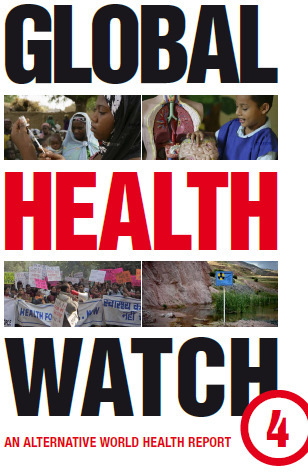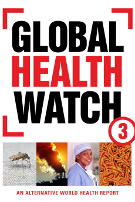EBSS 3.1 Overview of WHO Reform
Document
WHO reforms for a healthy future (EBSS/2/2)
Debate
See official record of debate, from page 34
Decision
PHM Comment and Report of Debate
Started under the rubric of the “Future financing” and driven by the need for a more predictable budget for the Organization, it suddenly went far beyond a financial reform, becoming a structural rethinking of the whole WHO.
It now encompasses three main fields identified in the DG's report (WHO Reforms for a healthy future', EBSS/2/2) and thoroughly discussed during the special EB session of November 2011: WHO’s programmes and priorities; the internal governance and WHO’s role in global health governance; and management reforms.
The rationale for the reform, presented by the Secretariat, is rooted in the fuel, food, environmental and financial crisis which have added the urgency for a strong cost-effective leadership in protecting the right to health globally.
Concerning the timing of the reform process, some of the countries, Serbia, Norway and India for instance, think that it should be slow downed, and that the analysis should be deepened.
See Official Record of this discussion, from page 34.
The DG Margaret Chan, during her opening speech, makes it clear: we are in shortage of resources, inequalities are widening and the health of millions of people hangs in the balance, WHO has to retain its leadership role producing better health outcomes and returning in the most efficient way of the investments done. According to the vision proposed, it requires alignment of objectives and better coherence at different levels - national, regional and global, as well as measurable results (e.g. number of lives saved and vaccines delivered, etc.), leveraging on the area where WHO has comparative advantage, otherwise called “core functions” or “core business”.
Both the Secretariat and Member States (MSs) have been continuously stressing the Member States-driven nature of the whole reform process, maybe due to the big concern that the latter showed in the consultations taken place before the EBSS. MSs are probably afraid of losing their leadership and control over what has been so far the authority in global health: WHO.
Since the first declarations, some key issues lead the discussion among MSs and create alignments or divisions which, more or less explicitly, shape the political geography of the Executive Board.
First of all, the nature of WHO is the very underlying discussion which, as a file rouge, sews the debate on every single issue. Some of the MSs, EU for instance, agree with the Secretariat on a WHO focused on “what it does best” , the above mentioned “comparative advantage”; while others, especially the emerging countries, such as India, Brazil and Ecuador on behalf of UNASUR, show a more comprehensive vision, affirming that WHO’s comparative advantage stems from its global legitimacy based on health systems strengthening, universal health coverage, access to affordable medication, social determinants of health. Therefore they look at WHO as a normative authority based on knowledge generation and sharing, with the main role of coordination of global health policies and of advocacy. The function of “convening body” is, instead, strongly sponsored by the DG and supported by USA.
Secondly, MSs debate on WHO’s role in the global health governance and the relation with other stakeholders, including both intergovernmental organizations and non-governmental organizations. Despite the broad consensus of the declarations that the WHO should remain the leader in the global health governance, positions on how to achieve it are largely divergent.
Big and powerful actors are playing in the global arena of health, most of which are non-health players – Margaret Chan says - and nonetheless have a great influence on the health agenda. The DG, hinting at the negotiations taking place at the neighbouring intergovernmental organizations, such as WTO and WIPO, at the public private partnerships, such as the GF, and also at the WB and IMF, blames the MSs to act incoherently, promoting inconsistent policies in the different organizations.
Concerning the NGOs, a big debate is going on, since no distinction is made by WHO between public-interest NGOs (PINGOs) and business-interest NGOs (BINGOs). This results in the trend of organizing global events very different in nature and principles, but both called “open to the civil society”, namely the Moscow Global Ministerial Conference on Healthy Lifestyles and NCDs Control, where the private sector was highly represented and the Rio WCSDH, where the civil society consisted of the Academy and grass-root movements and organizations. In this regard, MSs have very different positions: some, as India and Ecuador, are concerned about the influence that widening the engagement with other stakeholders can have in setting priorities and making decisions; Qatar, on the contrary, is very direct in proposing partnerships with the private sector. On the middle way, Brazil, which does not hide to welcome the increasing participation of civil society and private sector.
Among these different positions, caution seems to predominate, even though huge ambiguity still exists. MSs did not welcome the idea of the World Health Forum presented in the discussion papers arguing that it would duplicate the role of the WHO governing bodies, so the DG proposes three different formats for widening engagement (para 89-91 of the report):
- multi-stakeholder forums on key issues in global health;
- separate consultations with different groups of stakeholders to provide input on specific issues under consideration by Member States;
- consultations through face-to-face meetings or web-based forums.
In her welcoming speech, Margaret Chan has declared that the proposal for a WHF received little support and would not be developed further. Therefore a lot of participants as well as MSs are therefore asking themselves why the above-mentioned proposals, which especially at the para 89 seems to re-edit the WHF.
Thirdly, internal governance, including restructure of the organizations at the different levels are a major issue. Almost every countries supports the proposal to improve the work of the governing bodies at the three levels of the Organization, strengthening the linkages between global and country level. However, concerning the proposal to harmonize the practices of the Regional Committees, many MSs from Europe and South America express their concern about the “one size fit all” approach and promote an approach which would take more in account regional specifities.
Another thorny issue is the independent evaluation proposed by the DG in one of the concept papers. All MSs support this proposal emphasizing also the need to create a “culture of evaluation” within the whole Organization. However, the debate focuses on the modality (the two-stage approach has up to now received broad consensus), the timing and, above all, the selection of experts to conduct this evaluation: the external audit firms versus the Joint Inspection Unit (JIU), is the independent external oversight body of the United Nations.
A large debate takes place over the priority setting, in particular who will be in charge to and how to set priority. MSs are aware of the influence of donors on priority setting, and some of them, Norway first, call for strengthening the democratic dimension of WHO internal governance. MSs want the priority setting process to be strictly member states-driven, and agree on the need for ensuring greater coherence between priorities and financing. What MSs and how they will take the responsibility to grant WHO the adequate financing for the priority set, is still a big question. (For more detailed information and decisions taken go to the report over the discussion on “Programmatic Priorities”)
Finally, financing, initiator of the reform, appears to be the item of greater consensus. All MSs agree, at least in principle, on the need of larger predictability and flexibility of funding. WHO financing, they say, should be based as much as possible on assessed, not earmarked, contributions funded by MSs. Moreover the “collective financing approach” which is proposed by the DG’s report brings together different positions, although doubts raise with regard of criteria for setting priorities. This approach is characterized by the following features and sequence of events:
- a MS-driven process of priority-setting initiated at the Health Assembly for the next programme budget;
- once priorities are agreed and costed for the programme budget, a “financing dialogue” is held with all interested Member States and non-state donors (on a voluntary basis) after the WHA, led by the Programme, Budget and Administration Committee (PBAC), with the objective of securing sufficient collective financing for the programme budget.
In addition the Secretariat proposes a Contingency fund for the work of WHO in public health emergencies.
At the end of the first session, Madame Chan in the closing speech concludes saying: “I am listening you, my Member States. You want that WHO is publicly funded to keep the Organization independent, and not influenced by vested interested. You want WHO to stand up strongly against some powerful corporations, such as food industry”. Let’s see what will come up.
See Statement by WCC, PHM and DGH on WHO Reform read by Garance Upham
Return to SSEB Nov 1-3, 2011
| Attachment | Size |
|---|---|
| WCC-PHMStatement2SSEB_Item3WHOReform_111101.pdf | 38.93 KB |




